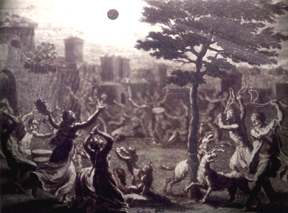Images courtesy SOHO (ESA & NASA). Animation by Windows to the Universe staff (Randy Russell).
Rotating Sun with Sunspots
This animation shows a large sunspot (officially dubbed sunspot number
720) moving across the face of the Sun as the Sun rotates. The animation
spans a
period
of about
two
weeks during January 2005. The Sun rotates one full turn every 25 days at
the equator, but it rotates slower at the poles, with one rotation every 36 days. Roughly 12 hours elapse per frame of
this animation.
The images were captured by the Michelson Doppler Imager (MDI) instrument
on
the
SOHO
(Solar & Heliospheric
Observatory) spacecraft. MDI images are captured in the red portion of the
visible
light spectrum, around a wavelength of 6,768 Angstroms. This part of
the spectrum is quite good for observing sunspots. The view is comparable to
what you would see if you could look at the Sun without damaging your eyes.
NEVER LOOK DIRECTLY AT THE SUN without taking appropriate safety precautions!
(Note: If you cannot see the animation
you may need to download the latest QuickTime player.)
You might also be interested in:

Sunspots are dark, planet-sized regions that appear on the "surface" of the Sun. Sunspots are "dark" because they are cooler than their surroundings. A large sunspot might have a central temperature of
...more
In recent years astronomers have become able to detect "starspots" on distant stars! Like the sunspots that frequently dot the "surface" of the nearest star, our Sun, starspots are relatively cool, dark
...more
Sunspots are caused by extremely strong, localized magnetic fields on the Sun. "Jet streams" of plasma that form deep within the Sun's convective zone produce powerful magnetic fields. When these loops
...more
Rising above the Sun's chromosphere , the temperature jumps sharply from a few tens of thousands of kelvins to as much as a few million kelvins in the Sun's outer atmosphere, the solar corona. Understanding
...more
Eclipses have been monitored for centuries, but it was only recently that we understood what really occurs. Eclipses have always been fascinating to watch, but they weren't always welcome. For many years,
...more
Most of the energy we receive from the Sun is the visible (white) light emitted from the photosphere. The photosphere is one of the coolest regions of the Sun (6000 K), so only a small fraction (0.1%)
...more
An eclipse of the Sun occurs when the Earth passes through the Moon's shadow. A total eclipse of the Sun takes place only during a new moon, when the Moon is directly between the Sun and the Earth and
...more














